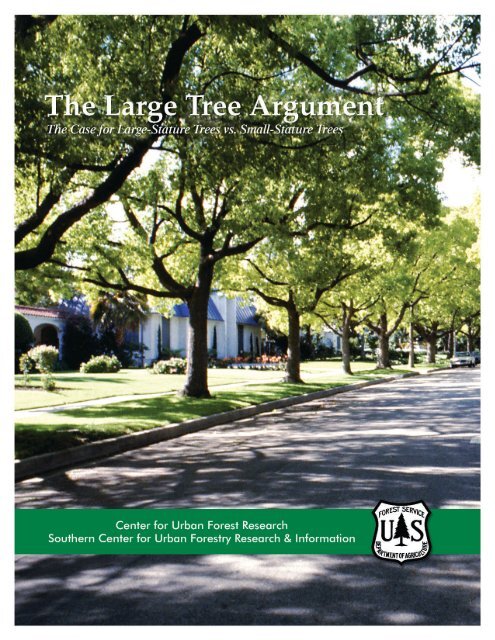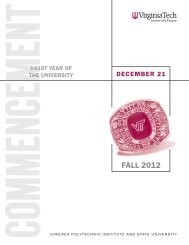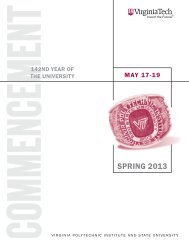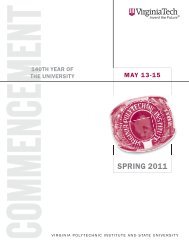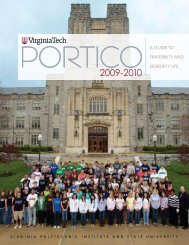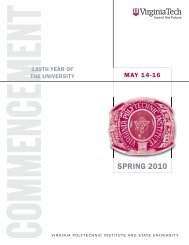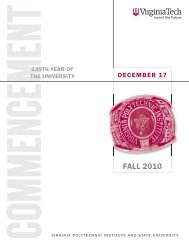The Large Tree Argument - USDA Forest Service
The Large Tree Argument - USDA Forest Service
The Large Tree Argument - USDA Forest Service
Create successful ePaper yourself
Turn your PDF publications into a flip-book with our unique Google optimized e-Paper software.
2<br />
Why did we like elm trees so much?<br />
<strong>Large</strong> stately elm trees once graced many<br />
communities throughout the US. But now<br />
they are gone. Why were entire communities<br />
so disappointed when they lost their elm trees<br />
to Dutch elm disease several decades ago?<br />
People had a sense that these large trees<br />
were important to them, their family, and<br />
their community. And this was long before we<br />
quantified the benefits of trees. Now we have<br />
scientific evidence for what these people knew<br />
decades ago.<br />
US Department of Agriculture<br />
<strong>USDA</strong> <strong>Forest</strong> <strong>Service</strong><br />
Center for Urban<br />
<strong>Forest</strong> Research<br />
Pacific Southwest<br />
Research Station<br />
<strong>USDA</strong> <strong>Forest</strong> <strong>Service</strong><br />
Southern Center for<br />
Urban <strong>Forest</strong>ry Research<br />
& Information<br />
Southern Research Station<br />
<strong>USDA</strong> <strong>Forest</strong> <strong>Service</strong><br />
Urban & Community <strong>Forest</strong>ry<br />
State & Private <strong>Forest</strong>ry<br />
<strong>USDA</strong> <strong>Forest</strong> <strong>Service</strong>
3<br />
<strong>Large</strong> trees pay us back<br />
We now know that, dollar for dollar,<br />
large-stature trees (see sidebar<br />
definition p.6) deliver big savings<br />
and other benefits we can’t<br />
ignore. Small-stature trees like<br />
crape myrtle deliver far fewer<br />
benefits. In fact, research at <strong>The</strong><br />
Center for Urban <strong>Forest</strong> Research<br />
shows that their benefits are up to<br />
eight times less.<br />
Compared to a small-stature tree,<br />
a strategically located large-stature<br />
tree has a bigger impact on conserving<br />
energy, mitigating an<br />
urban heat island, and cooling a<br />
parking lot. <strong>The</strong>y do more to<br />
reduce stormwater run off; extend<br />
the life of streets; improve local air,<br />
soil and water quality; reduce<br />
atmospheric carbon dioxide; provide<br />
wildlife habitat; increase<br />
property values; enhance the<br />
attractiveness of a community; and<br />
promote human health and well<br />
being. And when we use largestature<br />
trees, the bottom-line benefits<br />
are multiplied. When it comes<br />
to trees, size really does matter.<br />
Don’t forget the<br />
established “Old Guard”<br />
We can’t forget the already-established<br />
trees. <strong>The</strong>se older trees provide<br />
immediate benefits. <strong>The</strong><br />
investment that community leaders<br />
made 30, 40, 50 years ago is<br />
producing dividends today. Dr.<br />
McPherson, Director of the Center<br />
for Urban <strong>Forest</strong> Research, points<br />
out that “since up-front costs to<br />
establish these large-stature trees<br />
have already been made, keeping<br />
these trees healthy and functional<br />
is one of the best investments<br />
communities can make.”<br />
What do you lose if you<br />
don’t plant large trees?<br />
Municipal tree programs are<br />
dependent on tax-payer supported<br />
funding. <strong>The</strong>refore, communities<br />
must ask themselves, are<br />
large-statured trees worth the<br />
price to plant and care for? Our<br />
research has shown that benefits<br />
of large-statured trees far outweigh<br />
the costs of caring for them,<br />
sometimes as much as eight to<br />
one. <strong>The</strong> big question communities<br />
need to ask is: can we afford<br />
not to invest in our trees? Are we<br />
willing to forego all of these benefits?<br />
Or, would we rather make a<br />
commitment to provide the best<br />
possible care and management of<br />
our tree resource and sustain these<br />
benefits for future generations.<br />
Costs vs benefits<br />
In most areas of the country, communities<br />
can care for their largest<br />
trees for as little as $13 per year,<br />
per tree. And, each tree returns an<br />
average of $65 in energy savings,<br />
cleaner air, better managed<br />
stormwater, extended life of<br />
streets, and higher property values.<br />
Even at maturity, smallstature<br />
trees do not come close to<br />
providing the same magnitude of<br />
benefits.
4<br />
A hypothetical example<br />
A few years ago, the community of Greentree was faced with a budget crisis and decided to save money by downsizing its<br />
community forest—planting a majority of small-stature trees like crape myrtle in favor of large-stature trees like ash and<br />
even replacing large trees with smaller ones (see below). It made choice X. Unfortunately, this is not an uncommon story in<br />
communities today. But the real question is, what did they give up in return, and was downsizing a wise choice?<br />
Table 1: <strong>Large</strong> trees vs small trees<br />
<strong>The</strong> city of Greentree chose planting scenario X. By year 20 it was already a $60,000 annual mistake (see discussion above).<br />
CHOICE X<br />
CHOICE Y<br />
Avg. Ann. Benefit # Total Benefit # Total Benefit<br />
Avg. Ann. Cost <strong>Tree</strong>s Total Cost <strong>Tree</strong>s Total Cost<br />
<strong>Large</strong> <strong>Tree</strong>s $65.18 259 $16,882.00 1,693 $110,350.00<br />
$13.72 $3,553.00 $23,228.00<br />
Medium <strong>Tree</strong>s $36.04 753 $27,138.00 753 $27,138.00<br />
$6.87 $5,173.00 $5,173.00<br />
Small <strong>Tree</strong>s $17.96 1,693 $30,406.00 259 $4,652.00<br />
$6.23 $10,547.00 $1,614.00<br />
Total <strong>Tree</strong>s 2,705 2,705<br />
Total Benefits $74,426.00 $142,140.00<br />
Total Costs $19,273 $30,015.00<br />
Annual Net Value to Community $55,153.00 $112,125.00<br />
Note: Each “tree” represents 259<br />
trees planted.<br />
In this case, the city decided that<br />
planting 1693 small-stature trees<br />
and only 259 large-stature trees<br />
would be a good budget-cutting<br />
strategy. Over the short term this<br />
may save the city a little money.<br />
But over the long term they will<br />
have decidedly fewer benefits and<br />
a decreased quality of life. City<br />
elected officials failed to consider<br />
what the city would be giving up<br />
over the life of those trees.<br />
Will people want to live, work,<br />
recreate, do business, and shop in<br />
this community? And will the<br />
new trees provide all of the benefits<br />
that the residents seek—energy<br />
conservation, clean air, clean<br />
water, attractive surroundings,<br />
and enhanced real estate values.<br />
<strong>The</strong> answer is a resounding NO!<br />
<strong>The</strong> growth of these trees was<br />
modeled by <strong>The</strong> Center for Urban<br />
<strong>Forest</strong> Research over 40 years. By<br />
year 20, the decision-makers had<br />
already made nearly a $60,000<br />
dollar annual mistake.<br />
Choice Y is clearly the way to go<br />
to maximize their return on budget<br />
dollars. <strong>The</strong> model shows that<br />
once the trees are mature the community<br />
will receive an annual<br />
return on investment of nearly<br />
$60,000 over choice X. Plus, the<br />
community will look quite different<br />
in the future and be a healthier<br />
and safer place to live.
5<br />
Is it possible to recreate<br />
the past ?<br />
We may never have the arching<br />
canopies we once had with the<br />
stately elms of a few decades ago.<br />
But, we can still achieve large,<br />
extensive and functional canopies<br />
and reap all the benefits. It will take<br />
planting large-stature trees in as<br />
many appropriate places as possible<br />
while creating the best possible site<br />
that maximizes space and allows for<br />
adequate exchange of gases and<br />
water. And yes, it is possible!<br />
Editors Note<br />
We recognize that on some restricted<br />
sites small-stature trees may be the best<br />
choice. However, let’s not succumb to<br />
the limited space argument so easily.<br />
We need to continue to fight for more<br />
space for trees in every new project and<br />
every retrofit. <strong>The</strong> bigger the tree, the<br />
bigger the benefits and, ultimately, the<br />
better our quality of life.<br />
<strong>The</strong> Future Without<br />
<strong>Large</strong> <strong>Tree</strong>s<br />
Cities that are using smallstature<br />
trees to reduce<br />
costs may achieve some<br />
short-term savings, but<br />
over the long term, they<br />
have destined themselves<br />
to a future with fewer and<br />
fewer benefits as largestatured<br />
trees are replaced<br />
with smaller ones.<br />
Photo Credits:<br />
Cover - ©2004 Matton Images<br />
Page 2 - ©1870 Appleton’s Journal,<br />
Vol. 3, Issue 42<br />
Page 5 - ©2004 Kudzu Graphics<br />
Fact Sheet 1 - ©2004 Matton Images<br />
Fact Sheet 2 - ©2004 Matton Images
6<br />
What are trees worth?<br />
<strong>The</strong> value of tree benefits varies widely, but can be as much as $80 to $120 per tree per year for a large tree. Small<br />
trees that never get very large, like the crape myrtle, provide not much more than $15 in benefits on average. In<br />
some cases they are a net loss to communities after the costs are subtracted. <strong>The</strong> Center for Urban <strong>Forest</strong> Research<br />
has studied large, medium, and small trees in a number of locations throughout the West and found that, on average,<br />
mature large trees deliver an annual net benefit two to six times greater than mature small trees:<br />
Mature tree size<br />
<strong>The</strong> approximate tree<br />
size 40 years after<br />
planting.<br />
Relative Size<br />
at Maturity:<br />
Small-stature<br />
Less than 25 feet tall<br />
and wide with trunk<br />
diameters less than 20<br />
inches.<br />
Medium-stature<br />
25 - 40 feet tall and<br />
wide with trunk diameters<br />
20 - 30 inches.<br />
<strong>Large</strong>-stature<br />
Greater than 40 feet<br />
tall and wide with<br />
trunk diameters commonly<br />
over 30 inches.<br />
<strong>Large</strong> <strong>Tree</strong> • Total benefits/year = $55<br />
• Total costs/year = $18<br />
• Net benefits/year = $37<br />
• Life expectancy = 120 years<br />
• Lifetime benefits = $6,600<br />
• Lifetime costs = $2,160<br />
• Value to community = $4,440<br />
Medium <strong>Tree</strong> • Total benefits/year = $33<br />
• Total costs/year = $17<br />
• Net benefits/year = $16<br />
• Life expectancy = 60 years<br />
• Lifetime benefits = $1,980<br />
• Lifetime costs = $1,020<br />
• Value to community = $960<br />
Small <strong>Tree</strong> • Total benefits/year = $23<br />
• Total costs/year = $14<br />
• Net benefits/year = $9<br />
• Life expectancy = 30 years<br />
• Lifetime benefits = $690<br />
• Lifetime costs = $420<br />
• Value to community = $270<br />
—hypothetical case using data for trees at year 30, projected to life expectancy from McPherson, E.G.; et. al. 2003. Northern<br />
mountain and prairie community tree guide: benefits, costs and strategic planting. Center for Urban <strong>Forest</strong> Research, Pacific<br />
Southwest Research Station, <strong>USDA</strong> <strong>Forest</strong> <strong>Service</strong>. 92p.
Fact Sheet: Making the Case for <strong>Large</strong> <strong>Tree</strong>s<br />
<strong>Large</strong>-stature trees need to be “marketed” as maximizing urban benefits:<br />
Cooling the air<br />
Shading paved surfaces<br />
Improving air and water quality<br />
Preventing water runoff and soil erosion<br />
And enhancing residential and commercial value<br />
Even with these well-documented benefits, the<br />
challenges for increasing the number of large trees are<br />
consistently related to construction and preservation<br />
issues, space and persuading the community. Increasing<br />
the number of larger trees requires a combination of<br />
strategies that address these obstacles.<br />
Construction and preservation obstacles<br />
Consider both the preservation and planting of large<br />
trees in planning and design. Preserving large trees during<br />
construction:<br />
Start early in the process.<br />
Designate which trees need to be preserved. <strong>Large</strong>r<br />
more mature trees (that are in good condition) provide<br />
more value and benefits than smaller ornamental<br />
trees.<br />
Advise construction management of project schedules<br />
related to season-specific activities such as root<br />
pruning, fertilization, and insect control.<br />
Educate construction crews and the community<br />
about their role in preserving trees:<br />
• Soil compaction<br />
• Trunk and branch damage<br />
• Over or under watering<br />
• Chemical spills<br />
Pay careful attention to accidental damage, utility<br />
activities, or onsite crews that may impact the<br />
root system or soil composition.<br />
Accommodate utility lines near the critical root<br />
zone (CRZ), especially for larger trees by:<br />
• Tunneling under the tree root mat to install<br />
utility lines. This does little damage compared<br />
to trenching through the roots.<br />
• Use a pneumatic excavating tool for excavation<br />
work that must happen inside the CRZ.<br />
This tool can remove soil around tree roots<br />
without harming them.<br />
At the end of construction, plan for additional<br />
care as part of a recovery phase including<br />
watering, insect and disease control, and pruning.<br />
- adapted from work by Charlotte King, President, Snowden &<br />
King Marketing Communications
Finding space<br />
Accommodating larger trees is an ongoing challenge that is complicated<br />
by the competing needs for utility lines and impervious<br />
surfaces. Here are a few suggestions to address the issue of space<br />
during the planning and design phase:<br />
• Recommend planting large-stature trees as part of transportation<br />
corridors whenever possible.<br />
• <strong>Tree</strong> roots generally stay in the upper 18 inches of soil; therefore,<br />
ensure that pipes such as gas, electric, communication and water<br />
are installed deeper and use the space above for trees.<br />
• A new publication, “Reducing Infrastructure Damage by <strong>Tree</strong><br />
Roots: a Compendium of Strategies,” clearly outlines ways to<br />
install large trees in limited space so they coexist in harmony<br />
with hardscape. It is available through the Western Chapter ISA<br />
at http://www.wcisa.net.<br />
This fact sheet is provided for you to copy and distribute. Please credit the Center for Urban<br />
<strong>Forest</strong> Research, Pacific Southwest Research Station, <strong>USDA</strong> <strong>Forest</strong> <strong>Service</strong>, Davis,<br />
California and the Southern Center for Urban <strong>Forest</strong>ry Research & Information, Southern<br />
Research Station, <strong>USDA</strong> <strong>Forest</strong> <strong>Service</strong>, Athens, Georgia. 2004<br />
Persuading the Community<br />
You are the tree expert, and the public is looking to you for guidance and best practices that they can rely on for<br />
critical decisions related to budgeting, construction, esthetics, and long-term environmental impact. You also have an<br />
opportunity to talk with them about selection, preservation, and critical maintenance of trees, and persuade them that<br />
the benefits of larger trees far outweigh the costs:<br />
1. Explain the benefits of the larger trees and point out the obstacles. Discuss ways to mitigate<br />
these obstacles as described above in terms of construction, preservation, or space.<br />
2. Play an active role in the construction process to limit<br />
the damage done to trees, and identify post-construction<br />
tree care. Make sure the community understands<br />
the ongoing tree care requirements.<br />
3. Increase your “marketing expertise” in leveraging<br />
the value of community partners, media recognition,<br />
or historic preservation status. A little recognition<br />
combined with community education can make a big<br />
difference in changing the commitment to including<br />
larger trees in community projects.


